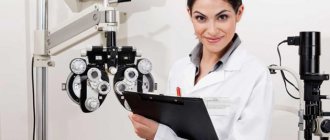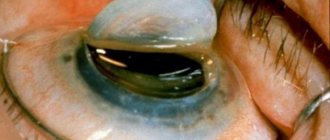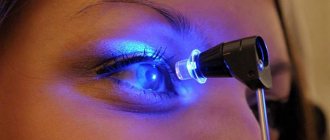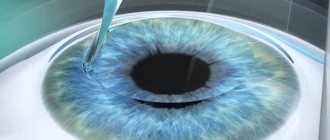For patients diagnosed with astigmatism, laser surgery is one of the possible treatment options. Surgical intervention is justified if:
- a person wants to stop depending on glasses;
- experienced intolerance to contact lenses;
- cannot correct vision by 100% with them;
- has a high degree of astigmatism;
- combines this diagnosis with farsightedness in the anamnesis.
Manipulations are carried out from the age of 18 in the absence of contraindications and changes in refraction over the past year.
How does astigmatism manifest?
An eye without refractive error is called emmetropic. The light rays are focused at one point on the retina, creating a full-fledged, clear image.
With astigmatism, the rays cannot focus at one point on the retina; two foci are formed, which can be located at different distances, both in front and behind the retina. The combination of the location of the foci relative to the retina largely determines the classification of astigmatism. In fact, the image that forms on the retina is not the same at every point, and the object appears elongated, altered. For example, a circle will look like an ellipse. This anomaly is usually congenital and has a genetic origin. It can also occur after injury, infection, or corneal pathology such as keratoconus.
Often, astigmatism is first diagnosed during a preventive examination or at an appointment with an ophthalmologist for another eye disease, so it is important to undergo diagnostic ophthalmological examinations, starting in childhood, for timely detection and prescription of the necessary correction of astigmatism.
Progress of the operation
Stages of laser correction for astigmatism:
- A person sits on a couch.
- Drops with an analgesic effect are instilled.
- An eyelid speculum is installed.
- A special ring is introduced to determine the center.
- A flap is formed to allow laser treatment of the cornea.
- Correction is performed using the selected technology.
- The corneal flap is returned to its place and, if necessary, fixed with a lens.
- The operated organ is treated with anti-inflammatory drugs.
It is advisable that a relative meet the person after treatment and help escort him home.
What are the symptoms of astigmatism?
Symptoms of astigmatism vary depending on its type, associated refractive errors and the age of the patient. If the astigmatism is mild, then the patient has no obvious complaints, especially before the age of 25-30, although astigmatism may go unnoticed even at a later age.
The higher the degree of astigmatism, the more the patient perceives the image as blurred, altered or double. This does not depend on the distance of the object being viewed, nor on the involvement of accommodation in trying to obtain the clearest possible image.
If astigmatism is associated with hypermetropia, then when working near the patient may experience eye fatigue, redness, dizziness or headache and other asthenopic complaints.
Typical complaints of patients with astigmatism:
- Blurredness and doubling of objects located both near and far;
- Excessively rapid eye fatigue;
- Possible headache with visual strain;
- Relative improvement of the image at a certain head rotation;
- Redness of the eyes;
- Eye irritation;
- Squinting your eyes to see the image more clearly;
- Decreased vision at night.
Service cost
Depending on the method of laser correction of astigmatism, the clinic, and the degree of complexity of the disorders, the cost will vary. Minimum cost 25,000–30,000 rubles.
Laser vision correction for astigmatism is a highly effective technique for restoring visual functions. The risks of complications are extremely low, there is no pain. After treatment, you can completely forget about the problem of blurred vision.
Share the article on social networks. Tell us about your impressions of laser vision correction for astigmatism. Be healthy.
What are the types of astigmatism?
Astigmatism can be:
- simple - emmetropia is diagnosed in one of the meridians, and hypermetropia or myopia in the other;
- mixed - characterized by manifestations of myopia in one meridian, and hypermetropia in the other;
- complex - hypermetropia or myopia of varying degrees is diagnosed in both meridians.
According to the mechanism of occurrence, astigmatism is divided into:
- congenital;
- acquired.
In some cases, the cause of astigmatism may be associated not only with abnormalities of the cornea, but also with abnormalities of the lens, and there may also be distortion of perceived objects due to pathology of the central zone of the retina, which must be taken into account during the diagnostic examination of the patient.
Therefore, according to the location they are distinguished:
- Corneal astigmatism (most common);
- Lens astigmatism.
Contraindications
Treatment of astigmatism using a laser system has a number of limitations:
- Rapidly progressive myopia or hypermetropia;
- Ophthalmological abnormalities in the acute stage, characterized by inflammatory processes (for example, glaucoma or cataracts);
- Diseases of the endocrine system;
- Pregnancy and lactation period;
- Age less than eighteen and over forty-five years of age.
In the latter case, exceptions are possible; the final decision is made by the doctor after conducting a detailed diagnosis.
What is astigmatism?
This definition hides a violation of the refractive abilities of the visual apparatus, in which the shape of the cornea or lens changes or “potholes” appear on their surface. Patients with this diagnosis see the world around them vaguely, without clear contours.
Astigmatism is accompanied by rapid eye fatigue, light intolerance and headache. Symptoms clearly manifest themselves with prolonged stress on the visual apparatus.
In pathology, the curvature of the surface of the cornea has different indicators. This leads to an uneven and incorrect distribution of light fluxes on the retina, as a result of which the brain forms an incorrect image of surrounding objects.
The disease manifests itself under the influence of external factors or is congenital in nature.
Spectacle vision correction
Glasses to improve vision are the oldest and simplest method of correction. Of course, over hundreds of centuries they have not only changed, but also received a lot of modern modifications. You can find out everything about glasses here.
The main function of diopter glasses is to correctly focus light rays on the retina, making the picture clearer. Wearing glasses is recommended in the following cases:
- High myopia (up to –30 diopters),
- High farsightedness (up to +10 diopters),
- Astigmatism (+/- 6 diopters),
- Childhood,
- Age-related farsightedness,
- Contact lens intolerance
- Contraindications to surgical or laser interventions.
There are also certain restrictions:
- Risk of injury (sports, active lifestyle),
- A field of activity that requires a full range of vision (for example, a pilot or a firefighter),
- A number of mental illnesses
- Anisometropia (large difference in diopters of the left and right eyes),
- Individual intolerance.
Glasses are the only correction method with additional functionality: the lenses protect the surface of the eye well from wind, dust, rain or bright sun. They are easy to use (you can take off and put on glasses at any time), do not require special care products (unlike lenses), are affordable and varied (you can choose several models - from the simplest to the stylish “go-out” one).
In some cases, prescription glasses are the only way to improve vision. For example, surgery is not recommended at an early age, and it is not possible to put lenses on a tiny child.
For presbyopia, double correction is possible - glasses are combined with special contact lenses.
The disadvantages of spectacle correction include:
- Limited visibility (glasses do not capture peripheral vision and distort spatial perception);
- Side effects (if selected incorrectly and/or worn for a long time, headaches, dizziness, and fatigue may occur);
- Unpleasant “special effects” (glasses fog up when the temperature changes, when there is snow or rain, drops settle on the glasses);
- Risk of eye damage (for example, from a fall);
- Limited activity (you cannot engage in contact and active sports with glasses).
For functional disorders, special glasses are used for correction.
What diagnostics are performed for astigmatism?
Diagnosis of astigmatism is carried out during an ophthalmological examination with the obligatory determination of visual acuity without correction and under conditions of optimal correction. There are many ways to diagnose astigmatism:
- The Snellen chart is used to test visual acuity;
- Optotypes for determining astigmatism;
- The autorefractokeratometer allows you to measure the optical power of the eye and the astigmatic component;
- Biometer is an optical device for measuring various structures of the eyeball, including indicating the presence of astigmatism;
- Keratotopograph is a device capable of accurately measuring the parameters of the cornea at each point on both the front and back surfaces, which is a unique diagnostic criterion;
- Keratometer , used to measure the curvature of the cornea;
- A subjective refractive test is necessary to obtain proper confirmation of astigmatism;
- Optical coherence tomography of the cornea.
Contoura Vision (SuperLasik)
Excimer laser vision correction using the Contoura Vision method is a technology that meets the highest standards of world ophthalmology. This is the pinnacle of quality in refractive surgery.
The peculiarity of this method is the precise laser “resurfacing” of the cornea based on the results of computer diagnostics of its surface
The diagnostic line allows you to evaluate the optical power of the eye as a whole , and thanks to an individual approach, the anatomical structure of the eye is preserved as much as possible.
This doesn't mean the standard option is bad. But there are cases when personalized is better and preferable. Each specific case must be considered by the surgeon separately and, based on data on the patient’s vision and the capabilities of the clinic, a conclusion is made about the preference for Contoura Vision.
The difference between the standard method and Contoura Vision is the second stage of correction - the effect of the excimer laser on the corneal stroma .
In the case of Contoura Vision , the computer program (algorithm) by which the laser operates includes more parameters and takes into account the individual characteristics of the optics of a particular patient's eye.
Advantages of the CONTOURA Vision method:
— High precision of corneal flap formation — Selection of parameters for each patient — Wide range of functions for maximum convenience — Personalized correction protocol — High visual acuity, full depth of focus and better quality of vision
Igor Borisovich Soloveichik, head of the refractive department of the TsLKZiM, will tell you about the method:
How can astigmatism be corrected?
The most effective methods for correcting astigmatism are:
- Temporary or reversible correction of astigmatism (spectacle or contact correction),
- Permanent (surgical).
The last category includes various methods of excimer laser refractive surgery, including femto-assisted surgery (PRK, LASIK, REIK, FEMTO LASIK).
If it is impossible to use laser operations, implantation of toric phakic lenses or implantation of intraocular toric lenses is performed. Thanks to these innovative methods, it is possible to change the shape of the cornea and correct not only astigmatism, but also other associated visual impairments (myopia, hypermetropia). During a diagnostic examination, our ophthalmologist will determine individually which method of astigmatism correction is most suitable for each patient.
What is temporary correction of astigmatism?
Astigmatism can be corrected temporarily or permanently. Temporary correction of astigmatism involves the use of contact lenses or glasses. The optical design of a spectacle glass or contact lens allows you to take into account all the nuances of the redistribution of diopters along various meridians. However, spectacle and contact correction of astigmatism have both their positive aspects and disadvantages. Wearing glasses or contact lenses often causes discomfort and headaches - the eyes quickly get tired or cannot adapt to the new correction at all.
Glasses are absolutely indispensable for the patient and give him the opportunity to have good vision, but over time they can become uncomfortable, annoying for those who have to use them daily and depend on them.
Contact lenses are more convenient, but also have a lot of disadvantages and, in addition, can lead to pathology of the cornea, conjunctiva, eyelids, and cause dry eye syndrome. However, today you can take a different path and restore your vision using laser vision correction surgery and forget about addiction and poor vision forever.
What is permanent astigmatism correction?
Astigmatism can be permanently corrected, thereby ensuring the patient's visual acuity remains consistently high. Intervention for the final correction of astigmatism is performed using PRK, LASIK, REIK, FEMTO LASIK techniques and is recommended for those who have any degree of astigmatism, as well as any other visual anomalies.
For the final permanent correction of astigmatism (and any other associated visual defects) in our clinic, ophthalmic surgeons use the best surgical and laser equipment of the latest generation, high-tech techniques and safe, uniquely accurate femtosecond and excimer lasers.
The combination of two advantages - the best equipment and highly qualified surgeons - undoubtedly gives an excellent result: high visual functions and improved quality of life.
Laser treatment of astigmatism is indicated for patients with refractive disorders of the optical functions of the eye. It is correction using a laser beam that allows you to eliminate all visual optical disturbances and return good vision to the patient.
Method of Svyatoslav Fedorov
In the 80s of the 20th century, the method developed by the doctor Svyatoslav Fedorov gained great popularity.
Few people, except specialists, have heard of the excimer laser. But it was with its help that it became possible to carry out ultra-precise operations to restore vision.
Its history begins in the mid-seventies. Ophthalmologists became very interested in developments related to the laser beam. It was used at that time in the computer field to engrave microchips. A number of experiments have shown that the laser beam, with its unique ability to accurately calculate the depth of application, will become an indispensable tool in eye surgery. To this day, the then-discovered technique is the most reliable in vision correction. What types of operations exist?
Laser treatment
Today, many surgical methods are used. This includes keratoplasty, microsurgery, and so on. But the most popular method is laser correction. It is as safe and painless as possible, since the shape of the cornea is restored by burning the organ, which makes the surface smooth.
But there are several techniques in laser therapy. This could be Lasik, PRK, Femto-Lasik, REIC. In a word, there are many of them, but only a doctor can choose the procedure that suits you.
How are they different from each other? Just a method of influence, but the essence of the treatment is the same. During laser surgery, the optical properties of the visual apparatus and other parameters must be taken into account. The correction does not take much time and does not have a rehabilitation period, since the patient can go home immediately after the operation. But for a month it will be necessary to limit the carrying of heavy objects, not to visit the bathhouse, not to take an excessively hot bath and not to drink alcohol.
Lasik
Lasik
An option for laser vision correction is LASIK (read 'leysik', in Russian it is usually pronounced as LASIK or LASIK). Most often, this operation is performed to correct myopia, astigmatism and farsightedness.
The key point of LASIK vision correction surgery is the creation of a so-called flap from the superficial layers of the cornea using a special cutting instrument microkeratome .
You will get something similar to a flap in an enlarged and rough form if you try to trim a thin layer of the surface of an apple , carefully moving along the skin, holding the knife blade parallel to the layer being cut.
Due to the spherical shape of the apple (and the cornea), you will get a rounded cut. The cut is not continued to the end; it is not completely cut off from the main mass of the apple (or cornea), leaving a small stem.
The flap is tilted to the side on a pedicle, thereby exposing the inner layers of the corneal stroma.
Next comes the excimer laser.
A cold ultraviolet laser beam, when aimed at the substance of the cornea, literally causes it to evaporate .
In this way, it is possible to change the shape of the cornea and thereby its optical properties. The cornea, modified during the operation, refracts light rays with the required strength, and they are focused on the retina, causing clear vision .
After laser treatment, the flap is gently placed in place. As soon as this happens, the flap begins to fuse with the underlying cornea.
During the first 2-3 hours after surgery, the patient experiences a feeling of a foreign body, “sand” in the eyes, photophobia, and lacrimation. After a few hours, the patient begins to see quite well and feel comfortable.
After surgery : it is necessary to limit visual stress associated with working at close range for 2-3 weeks. It is not recommended to visit the bathhouse, sauna and swimming pool for 1 month. Limitation of physical activity, bending work, lifting weights over 10 kg - 1 month.
The patient has the right to a sick leave certificate for 2-4 weeks.
At the moment, Lasik surgery is performed less and less due to the advent of more modern and safe methods. More on this in the next paragraph.
What are the indications for laser vision correction?
Laser correction or correction of astigmatism is indicated:
- patients with astigmatism up to 6 diopters;
- patients with vision problems aged 18 to 50 years;
- patients with intolerance to spectacle correction;
- patients at risk of developing dry eye syndrome who use contact lenses;
- professional athletes or people who work in certain areas that require high-precision vision without the possibility of using temporary correction devices;
- patients with anisometropia.
In the above situations, laser treatment of astigmatism will be effective and will help the cornea acquire the correct spherical shape, eliminating the manifestations of astigmatism and obtaining high visual acuity, which will significantly improve the quality of life.
It is important to know! Taking into account the peculiarities of the development of the optical system of the eye in children, correction of astigmatism is carried out only for certain indications, exclusively by ophthalmologists specializing in working with children.
Femtosecond laser vision correction ReLEx SMILE
ReLEx SMILE is a new generation laser vision correction technique. The surgeon forms a kind of lens - a lenticule - directly in the inner layers of the cornea, which is removed through a micro-incision 2-4 mm long. In this way, the doctor gives the cornea the desired shape without resorting to creating a flap and removing it. Thanks to this, the ReLEx SMILE method can be performed even with dry eye syndrome, and this disease is a contraindication for most laser surgeries. Another difference between ReLEx SMILE and PRK and LASIK is a shorter rehabilitation period. It is clear that the patient will have to pay much more for such a service.
In general, all types of operations are absolutely safe and provide high guarantees. The choice of procedure depends on the condition of the patient’s visual organs and his financial capabilities.
Myths
There are many myths about laser vision correction for astigmatism. Let's try to dispel them.
- "It hurts". Not really. The maximum that you can experience during laser correction and after it is a feeling of discomfort, as if something has got into the eye, increased tearing.
- "Hospitalization required." This is a myth; treatment is carried out on an outpatient basis. You will return home on the day of surgery.
- "Long recovery period." In fact, this is not so: vision is restored the next day after laser correction, and unpleasant postoperative symptoms only bother you for a few hours.
- “Other eye pathologies will arise.” The likelihood of developing other ophthalmological pathologies does not depend on whether laser correction of astigmatism was performed.
- “Laser is dangerous, which confirms that it is contraindicated for children.” Modern laser systems are safe for health. A competent specialist knows how to configure the necessary characteristics of the device so as not to cause harm. Children are not treated with laser for astigmatism due to the fact that the eye has not yet fully formed.
- “After laser treatment, you will need to limit your lifestyle.” It is not true. After correcting astigmatism with a laser, you do not need to limit yourself in anything. After the end of the recovery period, you can perform any physical activity, play sports, or work on the computer.
- “Women who have not given birth should not undergo laser correction.” This is not true: laser does not affect future pregnancies and births.
- “Vision will still deteriorate after laser treatment.” The long-term effectiveness of the treatment received has been proven. Changes from laser exposure do not occur inside the eye, so visual impairment will not occur again. The only thing is that, regardless of laser correction, you may develop other diseases that lead to vision deterioration.
- “Perhaps after treatment there will be no effect.” This is excluded, since the laser changes the refractive properties of the cornea, which inevitably leads to improved vision.
Surgical treatment of astigmatism
What techniques are used for surgical correction of astigmatism?
In our Clinic we use modern, safe, high-precision methods for correcting astigmatism such as LASIK, REIK, FEMTO LASIK, FEMTO REIK, FEMTO SUPERLASIK, FEMTO SUPERREIK.
All these techniques are based on the principle of intrastromal refractive surgery and consist in forming a flap from a thin surface layer of the cornea and further processing the layers of the cornea with a laser beam.
LASIK technique
LASIK correction is a reliable, effective and affordable way to restore quality of vision to patients. During surgery, the ophthalmologist creates a flap, then the corneal stroma is ablated with a laser beam.
REIC methodology
Correction using the REIC method is an innovative development of doctors at Dr. Kurenkov’s Clinic. It consists of eliminating refractive errors with high precision using an excimer laser.
After changing the shape of the cornea and returning the flap to its place, the eyes are treated with saline, which avoids contamination and deformation.
FEMTO REIC
With the FEMTO REIC technique, flap formation with the highest possible precision is performed using a femtosecond laser, which eliminates the use of a blade, providing access to the stromal layer of the cornea without any contact inside the cornea, on which it is necessary to perform photoablation with an excimer laser. Accuracy, smoothness and evenness (including the formed corneal bed) ensure the best result of the operation.
What are the advantages of the FEMTO REIC technique?
The FEMTO REIC technique has a lot of advantages, both objective and subjective. Here are some of them:
- it is a particularly safe and extremely precise operation thanks to the use of a femtosecond laser;
- this is a painless intervention: a few drops of anesthetic action are enough to undergo the operation calmly and painlessly;
- the risks in the intraoperative and postoperative period are further reduced. Complications are kept to a minimum, also thanks to the high level of sterility guaranteed by the laser beam;
- the operation does not involve the use of blades or scalpels - therefore, there is no contact impact and inaccuracies;
- Postoperative recovery is faster than with other surgical methods.
This technology has the following advantages:
- safety and painlessness of correction;
- lack of postoperative dressing;
- the ability to predict the result before surgery;
- stability of the result obtained;
- preservation of the anatomical features of the outer shell of the eye;
- possibility of performing correction on both eyes at once.
PRK - photorefractive keratectomy (PRK - Photo Refractive keratectomy)
The first operation using the PRK technique was performed back in 1985. This was the first time the excimer laser was used in ophthalmic surgery. In photorefractive keratectomy, non-contact changes were made to the upper layers of the cornea using an excimer laser, while the internal structures of the eyeball remained intact. When using the PRK technique to correct ametropia, microdamages occur in the outer layers of the cornea, which change its shape during healing. At the same time, regeneration processes take quite a long time, so long-term use of special eye drops is required. Using this technique, it is impossible to correct vision on both sides.
The PRK technique is applicable to correct visual acuity in the following cases:
- Myopia within -1...-6 diopters;
- Farsightedness within +1…+3 diopters;
- Astagmatism from -0.5 to -3 diopters.
Features and types of operations
Laser correction of astigmatism is performed using several methods.
LASIK (Opti LASIK)
LASIK technology consists of normalizing the refractive power of the cornea by changing its shape. To do this, the operating doctor creates and bends a corneal flap using a microkeratotome. This allows laser exposure to be applied to the deep layers of the cornea. At the end of the operation, the flap is placed in its original place.
The advantage of this correction option is that the superficial layers of the cornea are not affected. This allows you to maintain the transparency of the shell. LASIK is effective for disorders not exceeding 3 diopters.
Femto LASIK
Femto-LASIK technology is used in people with thinning corneas and xerophthalmia. The advantage of femtolaser treatment over LASIK is that the flap is formed using a knifeless method. There is no need to make an incision because the infrared rays of the femtosecond laser delaminate the cornea. The dissection boundary is as smooth as possible, which improves the results of the operation and shortens the recovery period.
Super-LASIK (Opti-Q LASIK)
The Super-LASIK technique is an improved version of LASIK. It involves the development of a surgical program that takes into account the individual characteristics of visual perception disorders. The doctor analyzes distortions of the human cornea and models ways to correct the pathology. Super-LASIK is used to treat higher order distortions, which include astigmatism.
LASEK (Opti LASEK)
The LASEK technique differs in its effect not on the deep, but on the superficial layers of the cornea. After the end of the laser treatment, a lens is put on the eye to fix it and speed up recovery. The lens is removed after 3–4 days.
LASEK is good because the technique is suitable for thinned corneas, and also because it does not affect the deep layers.
Super-LASEK (Opti-Q LASEK)
The essence of Super-LASEK technology is similar to Super-LASIK. A preliminary analysis is carried out using a special system. Laser treatment is performed only on altered areas of the cornea.
Photorefractive keratectomy (OptiPRK)
The PRK method involves removing the epithelium. The curvature of the cornea is then precisely modified using a laser. After this, a contact lens is installed for 3-4 days, which is then removed.
Photorefractive keratectomy is associated with a long and unpleasant recovery period, since a wound surface remains. PRK is performed if LASIK technology is contraindicated.
Irreversible types of vision correction (eye surgery)
This group includes surgical methods: laser vision correction, implantation of intraocular lenses and refractive lens replacement.
Previously, surgical interventions on the eye were performed manually, using an ordinary scalpel. The invention of the laser helped improve the entire course of surgical intervention. Laser vision correction is being used more and more often.
Svyatoslav Nikolaevich Fedorov can rightfully be considered the founder of most modern surgical methods of vision correction. His developments made it possible to make a real breakthrough in the field of eye microsurgery.
Laser vision correction is performed for myopia, farsightedness, and astigmatism. There are many modifications of the method. But the essence of the method is this: by changing the shape of the cornea, the image is focused on the retina.
During intraocular lens implantation, a special lens is inserted into the eye.
In refractive lens replacement, the patient's own lens is removed and an artificial lens is placed in its place. Today, lens replacement is the only effective treatment for cataracts.
Implantation of intraocular lenses and refractive lens replacement are surgical interventions used for high degrees of myopia.
Modern microsurgical eye surgeries help many patients, in the truest sense of these words, to see the world and improve their quality of life.
On the other hand, any surgical intervention can have irreversible consequences and complications. Due to technical errors, the addition of an inflammatory process, or unaccounted for characteristics of the body, the effect of the operation may be absent. Weighing the existing risks, not all patients choose microsurgical intervention for vision correction.
It is impossible to say unequivocally that any method of vision correction is better than another. Each technique, each method has its own strengths and weaknesses. We can only summarize: thanks to the high level of development of ophthalmology, in most cases it is possible to effectively correct existing vision problems.
Refractive error affects 30−45% of the world's population. In the USA, 40% are myopic, in Japan - 30%, in Ukraine - 43%. In Russia, such pathologies occur in more than 40% of citizens. Today, various modern methods of vision correction exist and are successfully used.
Correction of impaired vision due to refractive errors is one of the most important problems in ophthalmology. This pathology is widespread, in addition, there is a tendency to increase the number of patients due to the development of science, technology, and the growth of urbanization, which leads to increased visual and psychological stress. Low visual acuity in patients impairs their ability to work, limits their ability to choose a profession and reduces their life activity.
Currently, glasses are used to correct vision defects, as well as contact, surgical and laser correction.
Correcting visual impairments with glasses.
You can also see the resemblance of glasses in ancient engravings. Modern frames have undergone a number of significant changes: they are light, comfortable, suitable for any type of face, with their help you can emphasize individuality and create a special image. However, this correction also has a number of disadvantages: narrowing the field of view, reducing, enlarging or distorting the image. In addition, representatives of some professions (pilots, artists, athletes, etc.) cannot use glasses. It is not always possible to compensate for the difference in visual acuity between the two eyes using glasses.
Contact correction
One of the most effective types of correction, as it does not narrow the field of view, reduce or distort images on the retina. Modern contact lenses satisfy patients from both cosmetic and socio-psychological aspects; they are easy to use and, when prescribed correctly, do not cause side effects, but in any case they are a foreign body for the eye, a mechanical irritant, an allergen and a source of accumulation of various protein deposits , microorganisms. Often lenses lead to disruption of nutrition and oxygen supply to the cornea, causing degenerative changes and swelling in it. In the specialized literature there is evidence that complications occur in 41% of patients (depending on the wearing mode and type of lenses). This method of correction is contraindicated in case of individual intolerance, chronic degenerative eye diseases, allergies, glaucoma, after acute inflammatory diseases and various surgical operations.
Surgical methods of correction
Among surgical methods, anterior radial keratotomy has become widespread in our country since 1978, in which myopia and astigmatism are corrected using incisions on the cornea. However, the result of any surgical intervention depends on a number of conditions. Even with competent surgical technique, high-quality medical instruments and highly qualified surgeons, the individual ability to heal affects the postoperative result, leading in some cases to hypoeffect, various astigmatisms, and image distortions.
Keratomylosis and orthokeratophakia are not widely used, as they are technically complex and traumatic, and require expensive equipment to perform them. Like any surgical operation, they require a long recovery period. Therefore, these correction methods have given way to more accurate and safe laser technologies.
Laser correction methods
To date, more than 100 million laser interventions have been performed worldwide for various refractive errors (myopia, farsightedness, astigmatism). The following types of excimer laser correction are known: photorefractive keratectomy, intrastromal keratomileusis (LASIK), laser epithelial keratomileusis (LASEK) and InCorr+ technology, used for hypermetropia. There are scanning and non-scanning laser systems. Non-scanning intervention does not require monotonous, exhausting fixation of the patient's gaze during the manipulation and forms a uniform, smooth surface of the cornea, which ensures the absence of image distortion after manipulation.
Photorefractive keratectomy has been used around the world since 1984, and in Russia since 1996. When using this method, the shape of the cornea changes due to laser evaporation of its superficial stromal layers. The treatment is technically easy to implement and, with non-scanning laser intervention, can completely eliminate myopia up to 13D and reduce higher myopia (with scanning intervention - up to 6.0D). However, during surgery it is necessary to remove the surface epithelial layer of the cornea mechanically or chemically. Therefore, in the postoperative period, patients note irritation and lacrimation. Recovery see
functional functions occur
on the third to seventh
day.
The LASIK operation is more modern; when it is used, a flap of the cornea is peeled off with a special tool and the deeper layers of the stroma are evaporated using a laser, after which the flap is returned to its usual place. LASIK surgery has a number of advantages: absence of pain after surgery, rapid restoration of visual functions, and the ability to operate on both eyes on the same day. However, world statistics for 1999 showed that out of 1 million operations using the LASIK
conducted around the world, 1 thousand patients experienced such a serious complication as protrusion of the cornea in the form of a cone with thinning and clouding of the stroma, and in some cases even with ulceration and perforation. Sometimes there is increased sensitivity of the cornea, accompanied by pain and photophobia. This complication arises due to the fact that LASIK surgery is performed in the deep layers of the corneal stroma and has limitations in cases of high myopia with a thin cornea. Long-term postoperative observation of patients in many laser surgery centers has shown that with this technique, many patients experience various distortions, contrast, and decreased vision in the dark. This prompted ophthalmologists to find new methods of laser correction.
Currently, a type of excimer laser correction of myopia has appeared - laser epitheliokeratectomy (LASEK - the author's technique), which is similar in technology to LASIK, but is performed without a corneal incision, that is, without disturbing the eye frame and its biomechanics. When using this technology, the possibility of developing keratoconus is completely excluded, since this operation is performed in the superficial layer of the cornea, damage to the deep layers is excluded, which is a significant advantage of the new LASEK method over the already known technology. After the LASEK operation, there is practically no pain syndrome, there is a rapid restoration of visual functions, there are no various distortions of objects, and the biomechanics of the eye is not disturbed. This operation is more physiological and has no restrictions for high degrees of myopia and various types of astigmatism. Treatment of astymatism and initial keratoconus is carried out in the extra-optic zone. According to foreign literature (since 1997), stable results are noted. After treatment, all patients returned to full-time work.
The InCorr+ technology (the author's method) is successfully used for hyperopia and presbyopia that appear after 40-45 years and force one to wear reading glasses (age-related farsightedness). This treatment is performed along the periphery of the cornea, thereby increasing the refraction of its center.
Where can you turn if a problem arises? New laser technologies and techniques are used to treat eye diseases and vision correction ! This allows you to perform operations with vision down to -20, treat farsightedness ; avoid complications after operations of any complexity!
Highly qualified specialists, candidates, doctors of science work here.
Modern equipment, a range of drugs and medications meet the highest world-class requirements.
The most advanced technologies and unique laser techniques existing in the world are used for the treatment of eye diseases and vision correction.
The Academic Center for Laser Medicine “Correct” is the only center in Moscow where high degrees of hyperopia are operated on using the new “In Corr +” technology, which guarantees 100% results and its stability.
o Laser vision correction
o Correction of myopia, farsightedness, astigmatism (excimer laser vision correction using FRK, LASEK, In Corr+ methods) with the latest German non-scanning laser In Pro GAUSS (WITHOUT CORNEA INECTION - the latest safe technologies)
o Laser coagulation of the fundus (complicated myopia, retinal dystrophy, edema, degeneration, diabetes, ruptures and retinal detachment)
o Laser treatment of amblyopia eyes
o Scleroplasty for progressive myopia
Based on site materials: https://correct-laser.ru/
March 20, 2006 | 00:03
Treatment for red eyes
Your eyes resemble a road map, decorated with bright lines. Maybe you swam in a chlorinated pool or drank too much beer at a picnic, or maybe you rubbed your eyes too hard. Any of these factors can cause the tiny blood vessels in the sclera to dilate, causing them to become red.
March 14, 2006 | 00:03
Help your eyes
Often in the evening the eyes become tired, become noticeably red, and characteristic pain appears in the temples and forehead. None of these symptoms are causeless. The pain can be caused by eye strain or infection, allergies or weakened functioning of internal organs. First, you should see a doctor to check your eye condition and visual acuity.
March 06, 2006 | 00:03
Diagnosis by iris
Let's say how sincere the interlocutor is, in what mood he is. When the soul is light and calm, a person’s eyes usually radiate inner warmth and joy. When the soul is filled with anxiety, the human gaze becomes prickly, tense and distrustful. In communication psychology there is a special area of study of human bodily behavioral reactions. These reactions are an external reflection of often hidden thoughts and feelings.
March 02, 2006 | 00:03
The fight against cataracts in Russia
Until now, one of the main causes of low vision and blindness is cataracts. According to the World Health Organization, half of the world's population develops cataracts and about 20 million people require surgical treatment. In Russia, cataracts are the main cause of reversible blindness among people over 60 years of age. You can often hear that cataracts are a film that grows before the eyes.
Vision correction, scientifically known as refractive surgery, corrects optical imperfections of the eye - nearsightedness (myopia), farsightedness (hypermetropia) and astigmatism. These visual impairments are associated with the anatomical structure of the eye - the length of the eye, optical power and the shape of the cornea.
In a healthy person, the optical system of the eye is designed in such a way that light is focused precisely on the retina of the eye, only then is it possible to have good vision.
Vision correction corrects the optics of the eye so that the light is focused strictly on the retina, only then is high vision possible
There are several main types of eye optics disorders that reduce the acuity and quality of vision.
Myopia
- light rays are refracted too strongly and focused in front of the retina.
Myopia can be combined with astigmatism. Farsightedness
- light rays are refracted too weakly, so the focus is behind the retina.
The combination of farsightedness and astigmatism further worsens vision. Astigmatism
- light rays are focused in several places. The focus can be either in front of the retina or behind the retina, making the image particularly blurry.
Methods and types of vision correction
Modern ophthalmology can offer the patient many ways to correct vision. We will look at their most basic types:
Laser vision correction is the most painless, safe and effective method, recognized by ophthalmologists around the world.
Contact lenses
- a very popular and convenient way to correct vision, if you get used to it.
There are many types of contact lenses to suit every taste and budget. However, it is worth noting that eyes rarely tolerate contact lenses after 15 years of continuous wear. Glasses
are the most proven method of vision correction.
Today, glasses are also a fashion accessory for your individual style and image. They can correct almost any vision problem. Modern lens materials and coatings provide high quality vision under all conditions. Intraocular microsurgical operations
to correct vision are used in cases where the patient has very high degrees of visual impairment.
For example, myopia of -18.0 diopters is almost impossible to correct with laser vision correction; all that remains is to replace the transparent lens with an artificial intraocular lens IOL. A similar situation arises with farsightedness of more than +6.0 +8.0 diopters. Microsurgical operations on the cornea
to correct vision are used for complex eye diseases. For example, keratoconus, a cataract or severe clouding of the cornea, cannot be corrected using traditional methods. A radical operation is required to replace the altered cornea with a donor transplant.
Pros and cons of vision correction
If we consider the advantages of vision correction using laser techniques, we can highlight the following advantages of these procedures:
Relieving the patient of dependence on glasses and contact lenses Predictable results of the operation High visual acuity No pain at all stages of the operation Quick procedure time Quick rehabilitation period Minimal risk of complications The procedure is performed on an outpatient basis, i.e. no need to stay in hospital The cost of correction is more profitable than long-term use of glasses and contact lenses
The disadvantages of vision correction occur in a small proportion of patients. They can have varying degrees of severity and in most cases disappear over time. The disadvantages may be the following:
Vision correction does not cure the disease, but corrects its consequence - poor vision. At high degrees of visual impairment, complete restoration of vision cannot be guaranteed. Some patients may develop dry eye syndrome. Some patients note halo effects around light sources, mainly in the evening. As myopia progresses, it may be necessary to repeat surgery There are a number of contraindications when correction cannot be performed
Vision correction for people over 40 years of age
If your age is approaching 40 years, then you will soon be faced with a natural age-related process - deterioration of near vision. This condition is called age-related farsightedness or presbyopia. At this age, the lenses begin to lose their elasticity and the intraocular ciliary muscle weakens, making near vision difficult. Absolutely anyone over 40 will face this problem, regardless of whether their vision was good or bad in their youth.
After 40 years, everyone develops age-related farsightedness - a person has difficulty seeing close up. It can be corrected with glasses, contact lenses, laser correction or surgery.
Modern ophthalmology offers such patients many options:
Reading glasses are the simplest and most common way to correct vision for age-related farsightedness. Progressive glasses - patients with myopia, farsightedness and astigmatism can choose progressive glasses that will give good vision at any distance. Multifocal contact lenses - different areas of the lens are responsible for good vision at different distances. Laser vision correction using the Monovision method, when one eye is adjusted for near vision, and the other for distance vision. The Presby LASIK method makes the cornea similar to a multifocal lens. Multifocal artificial lenses are implanted in place of the natural lens for life and provide good vision at all distances.
Gymnastics for the eyes and vision correction
As you already know, all eye diseases that cause visual impairment due to improperly formed optics of the eye are associated with changes in the structure of the eye - the length of the eye and the shape of the cornea or lens.
It becomes clear that gymnastics and eye exercises are unable to change the anatomy of the eye and restore the correct refraction of light for clear vision.
Of course, eye exercises are of great importance in the prevention of myopia and visual fatigue.
Which vision correction method is right for you?
Due to age-related changes in the eyes, indications for laser or other types of vision correction may change. Methods used in young patients may be contraindicated or undesirable in older people.
For example, children under the age of 18 whose bodies are constantly growing cannot be considered candidates for laser vision restoration due to eye growth, with rare exceptions for medical reasons.
The choice of vision correction method is influenced by age, gender, health status, and eye diseases. An important criterion is the profession and physical activity of the patient.
Lifestyle and occupation are very important criteria in choosing a method of vision restoration. People with intellectual work often require good near vision; computer users will prefer comfortable work at an average distance. Many professions require good distance vision and depth perception, such as pilots and drivers.
An examination and consultation with an experienced ophthalmologist will help you make the right choice for safe and effective vision correction.
How is the operation performed?
Laser correction of astigmatism consists of three stages:
- A flap is formed on the cornea and placed to the side.
- Using a laser, part of the cornea is evaporated, giving it the correct shape, which can significantly improve the patient’s vision.
- After giving the cornea a spherical shape, the previously folded flap of tissue is returned to its place and tightly fixed without treating it with suture material, which can significantly speed up regeneration after the intervention.
Laser surgery for astigmatism in both eyes takes 10 to 12 minutes. The intervention is performed under local anesthesia and does not cause discomfort. Vision is restored a few hours after the operation, and regeneration takes only a few days, without requiring the patient to stay in the hospital.
EPI-LASIK
EPI-LASIK is the most modern method of vision correction, retaining all the advantages of the Lasik method - rapid restoration of vision with minimal pain. EPI-LASIK is a superficial corneal sculpting procedure along with PRK and Lasik.
EPI-LASIK is considered the most suitable technique for patients with low levels of myopia, thin corneas, and in all cases where the formation of an epithelial flap may pose certain problems.
Laser exposure during surgery is performed on the surface of the cornea after removal of the epithelium (this is its similarity with PRK and LASIK). The ophthalmic surgeon does not use a microkeratome with a blade, but uses a special epikeratome to delaminate and separate the epithelial flap. By maintaining the viability of the epithelial flap, the healing process is more efficient, making patients feel much better than after PRK and LASIK procedures. Also, the Epi-LASIK method does not use an alcohol solution, this is its difference from the LASIK operation, and more than 80% of epithelial cells remain viable. After the epithelial flap is returned to its place, these cells are distributed throughout the cornea, creating a very smooth surface and a favorable environment for further restoration of epithelial cells.
Types of operation
Keratotomy
Keratotomy is a procedure for making incisions in the cornea. Before surgery, a comprehensive scan of the cornea is performed. The depth, length and location of the cuts are carefully calculated. The operation is performed under local anesthesia and usually lasts less than 5 minutes.
The surgeon cuts the patient's cornea directly with a scalpel. He applies peculiar notches to the fabric, thus changing the curvature of the refractive surface. As a result, this part of the cornea bulges under the influence of intraocular pressure and becomes narrower. This, in turn, changes its curvature. The operation has a fairly high rate of complications, so it is currently performed infrequently.
There are more modern modifications of it. It is possible to use tools with a diamond attachment, as well as a laser instead of a scalpel. In this case, the postoperative period is shorter, and the cornea heals faster. This method is practiced when insufficient thickness of the cornea prevents keratectomy (its partial removal).
Laser correction
The operation can be performed in two main ways - PRK (photorefractive keratectomy) and Lasik (laser-assisted intrastromal keratomyelosis). The first operation is used to correct mild forms of astigmatism. Lasik is suitable for correcting more serious forms of the disease (more than 3 diopters) and for concomitant farsightedness.
Laser intrastromal keratomyelosis is considered a more advanced technique. After it, complications are less common, the percentage of successful operations is slightly but higher, and it is also somewhat more accurate than PRK.
PRK
During this operation, the surgeon makes an incision into the epithelium and removes part of the tissue. It can be carried out with a scalpel, laser or using a chemical agent. Some installations allow you to do without this stage, in particular the Russian-developed device “Profile 500”.
Through the resulting hole, the laser beams reach the cornea. There, under their influence, the bonds between molecules and atoms are broken. As a result, the cornea is evaporated to the thickness required for correction.
Types of laser vision correction techniques
In ophthalmology, various techniques are used to restore vision in ametropia. The choice of one type or another often depends on the anatomical features of the eye, and sometimes on the patient’s preferences.
- LASIK is a traditional laser vision correction surgery. It has been used for a very long time. Over the years, several more advanced techniques have been developed.
- SuperLASIK differs from traditional surgery in that laser evaporation of the cornea is carried out not according to a template, but taking into account all the topographic data of the eyeball.
- FemtoLASIK differs only in the first stage of the operation, when a femtosecond laser is used to create a corneal surface flap, rather than a microkeratome.
- FemtoSuperLASIK is performed taking into account individual characteristics and using a femtosecond laser.
- PresbyLASIK is specifically designed to correct vision in older patients suffering from presbyopia.
- PRK is not used often due to the high risk of complications, pain and long rehabilitation. It is usually prescribed if there are contraindications to LASIK.
- Epi-LASIK is designed for patients with insufficient corneal thickness.
- SMILE is a fundamentally different method of laser vision correction. Using a laser, the corneal substance is not evaporated, but the lenticule is cut out with certain boundaries. The operation is characterized by low trauma, high efficiency and versatility.











